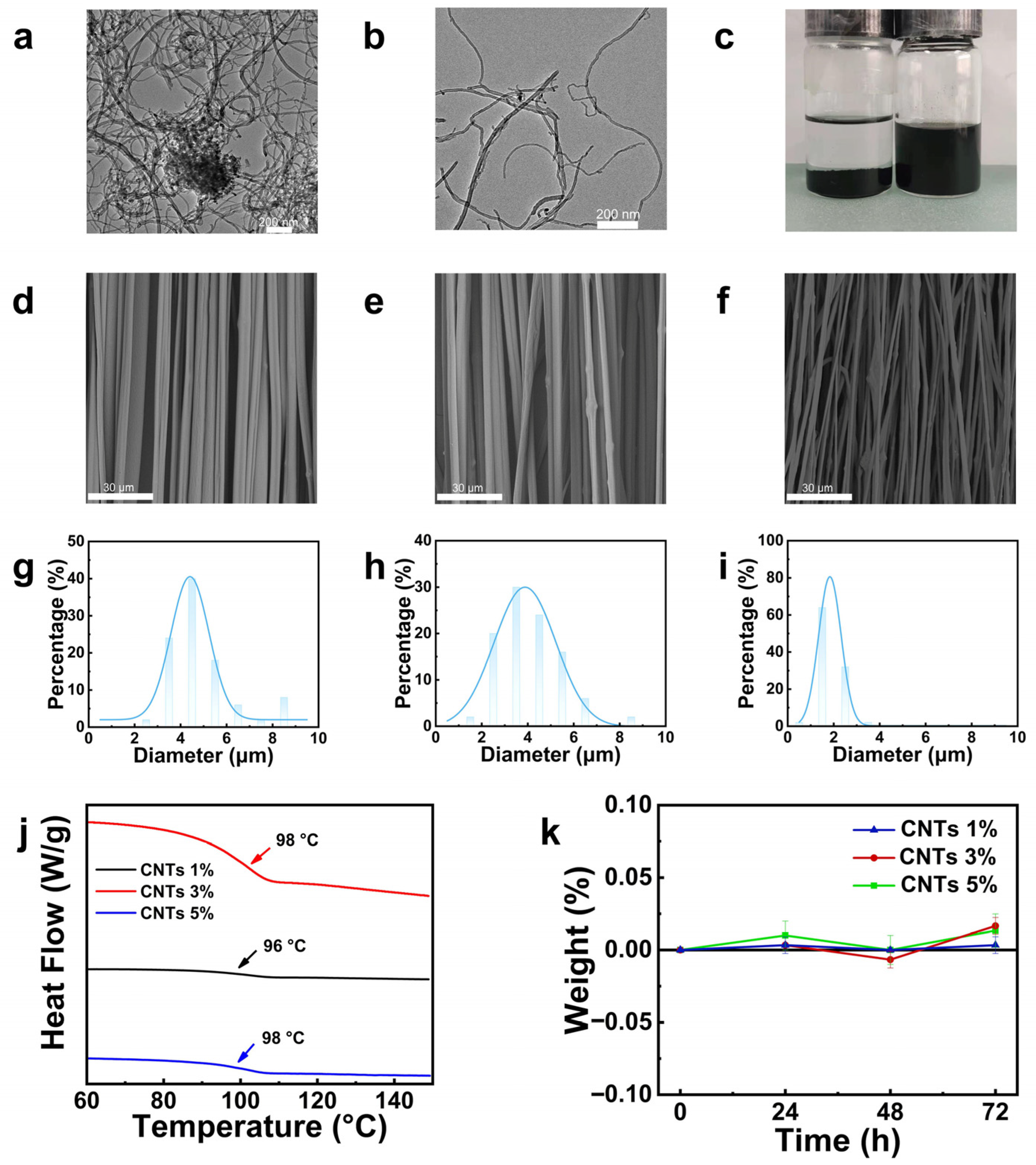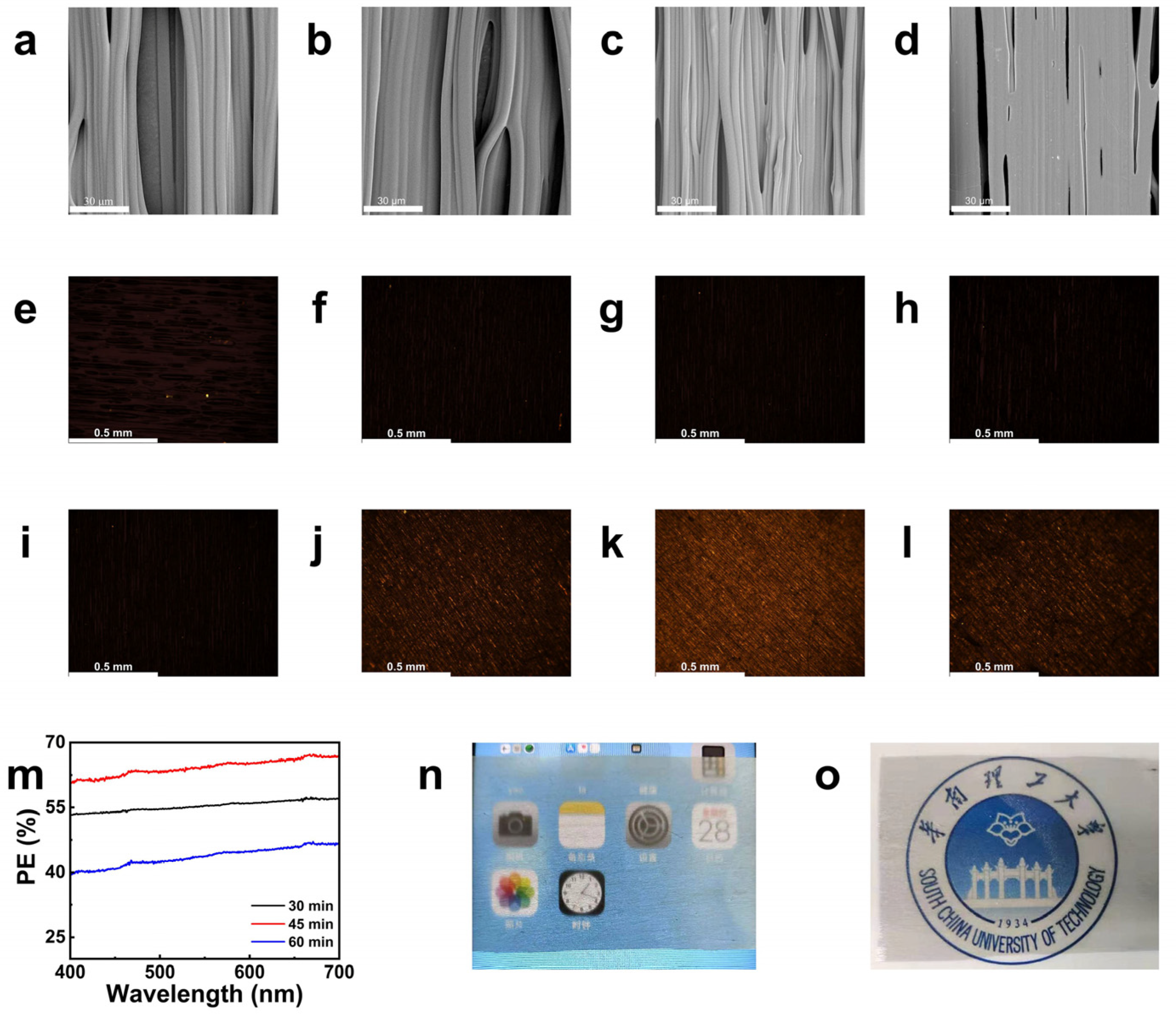Moisture-Resistant, High-Performance Polarizing Films via Aligned PMMA/CNT Composite Fibers: A Scalable Electrospinning Approach
Abstract
1. Introduction
2. Results and Discussion
2.1. Characterization of PMMA Fiber
2.2. The Effect of CNTs Concentration on the Morphology and Properties of PMMA/CNTs Composite Fibers
2.3. Effect of SVA on the Morphology and Properties of PMMA/CNTs Composite Fibers
2.4. The Effect of Stretching Amplitude on the Morphology and Properties of PMMA/CNTs Composite Films
3. Materials and Methods
3.1. Materials
3.2. Preparation of Light-Functional Fibers Film
3.2.1. Preparation of PMMA Fibers
3.2.2. Preparation of PMMA/CNTs Composite Fibers
3.3. Solvent Vapor Annealing (SVA) of Fibers
3.4. Uniaxial Stretching of SVA Fibers
4. Conclusions
Supplementary Materials
Author Contributions
Funding
Institutional Review Board Statement
Informed Consent Statement
Data Availability Statement
Acknowledgments
Conflicts of Interest
References
- Srivastava, A.K.; Zhang, W.; Schneider, J.; Rogach, A.L.; Chigrinov, V.G.; Kwok, H.S. Photoaligned Nanorod Enhancement Films with Polarized Emission for Liquid-Crystal-Display Applications. Adv. Mater. 2017, 29, 1701091. [Google Scholar] [CrossRef] [PubMed]
- Jung, T.; Choi, J.H.; Lee, S.J.; Jang, S.H.; Han, S.J. Performance optimization of polarized-light-emitting source based on aluminum metal grid for display application. Displays 2018, 53, 40–46. [Google Scholar] [CrossRef]
- Pan, S.; Ho, J.Y.; Chigrinov, V.G.; Kwok, H.S. Novel Photoalignment Method Based on Low-Molecular-Weight Azobenzene Dyes and Its Application for High-Dichroic-Ratio Polarizers. ACS Appl. Mater. Interfaces 2018, 10, 9032–9037. [Google Scholar] [CrossRef] [PubMed]
- Kim, D.Y.; Kim, M.J.; Sung, G.; Sun, J.Y. Stretchable and reflective displays: Materials, technologies and strategies. Nano Converg. 2019, 6, 21. [Google Scholar] [CrossRef]
- Qin, L.; Yang, J.T.; Wang, C.G.; Shen, C.; Wang, Y.B.; Tang, J.; Liu, J. Preparation and measurement of subwavelength bilayer metal wire grid polarizers on flexible plastic substrates. Opt. Commun. 2019, 434, 118–123. [Google Scholar] [CrossRef]
- Zhang, Z.L.; Zhang, Y.J.; Song, Y.X.; Pan, J.X.; Chen, J.Y.; Cao, Y. Effect of structural evolution and orientation behavior on optical properties of iodine-dyed PVA film during uniaxial stretching. Polymer 2024, 312, 127653. [Google Scholar] [CrossRef]
- Zhao, G.; Zhou, Y.S.; Wang, J.Y.; Wu, Z.H.; Wang, H.; Chen, H. Self-Healing of Polarizing Films via the Synergy between Gold Nanorods and Vitrimer. Adv. Mater. 2019, 31, 1900363. [Google Scholar] [CrossRef]
- Osewski, P.; Belardini, A.; Centini, M.; Valagiannopoulos, C.; Leahu, G.; Li Voti, R.; Tomczyk, M.; Alù, A.; Pawlak, D.A.; Sibilia, C. New Self-Organization Route to Tunable Narrowband Optical Filters and Polarizers Demonstrated with ZnO–ZnWO4 Eutectic Composite. Adv. Opt. Mater. 2020, 8, 1901617. [Google Scholar] [CrossRef]
- Greenfeld, I.; Camposeo, A.; Portone, A.; Romano, L.; Allegrini, M.; Fuso, F.; Pisignano, D.; Wagner, H.D. WO3 Nanowires Enhance Molecular Alignment and Optical Anisotropy in Electrospun Nanocomposite Fibers: Implications for Hybrid Light-Emitting Systems. ACS Appl. Nano Mater. 2022, 5, 3654–3666. [Google Scholar] [CrossRef] [PubMed]
- Kyoung, J.; Jang, E.Y.; Lima, M.D.; Park, H.-R.; Robles, R.O.; Lepró, X.; Kim, Y.H.; Baughman, R.H.; Kim, D.S. A Reel-Wound Carbon Nanotube Polarizer for Terahertz Frequencies. Nano Lett. 2011, 11, 4227–4231. [Google Scholar] [CrossRef]
- Arora, N.; Sharma, N.N. Arc discharge synthesis of carbon nanotubes: Comprehensive review. Diam. Relat. Mater. 2014, 50, 135–150. [Google Scholar] [CrossRef]
- Du, T.; Schneider, J.; Srivastava, A.K.; Susha, A.S.; Chigrinov, V.G.; Kwok, H.S.; Rogach, A.L. Combination of Photoinduced Alignment and Self-Assembly to Realize Polarized Emission from Ordered Semiconductor Nanorods. ACS Nano 2015, 9, 11049–11055. [Google Scholar] [CrossRef] [PubMed]
- Hecht, M.; Soberats, B.; Zhu, J.; Stepanenko, V.; Agarwal, S.; Greiner, A.; Würthner, F. Anisotropic microfibres of a liquid-crystalline diketopyrrolopyrrole by self-assembly-assisted electrospinning. Nanoscale Horiz. 2019, 4, 169–174. [Google Scholar] [CrossRef]
- Gupta, N.; Gupta, S.M.; Sharma, S.K. Carbon nanotubes: Synthesis, properties and engineering applications. Carbon Lett. 2019, 29, 419–447. [Google Scholar] [CrossRef]
- Kim, T.H.; Park, J.G.; Kim, Y.K.; Lim, Y.J.; Kang, J.-W.; Kim, E.S.; Kwon, J.Y.; Lee, Y.H.; Lee, S.H. An active carbon-nanotube polarizer-embedded electrode and liquid-crystal alignment. Nanoscale 2020, 12, 17698–17702. [Google Scholar] [CrossRef]
- Guo, H.; Kremer, K.; Soddemann, T. Nonequilibrium molecular dynamics simulation of shear-induced alignment of amphiphilic model systems. Phys. Rev. E 2002, 66, 061503. [Google Scholar] [CrossRef]
- Kim, J.; Peretti, J.; Lahlil, K.; Boilot, J.P.; Gacoin, T. Optically Anisotropic Thin Films by Shear-Oriented Assembly of Colloidal Nanorods. Adv. Mater. 2013, 25, 3295–3300. [Google Scholar] [CrossRef]
- Mahajan, M.P.; Rosenblatt, C. History-dependent orientational order of rubbed polyimide for liquid-crystal alignment. Appl. Phys. Lett. 1999, 75, 3623–3625. [Google Scholar] [CrossRef]
- Hu, Z.H.; Fischbein, M.D.; Querner, C.; Drndić, M. Electric-Field-Driven Accumulation and Alignment of CdSe and CdTe Nanorods in Nanoscale Devices. Nano Lett. 2006, 6, 2585–2591. [Google Scholar] [CrossRef]
- Liu, M.; Lagdani, J.; Imrane, H.; Pettiford, C.; Lou, J.; Yoon, S.; Harris, V.G.; Vittoria, C.; Sun, N.X. Self-assembled magnetic nanowire arrays. Appl. Phys. Lett. 2007, 90, 103105. [Google Scholar] [CrossRef]
- Long, Y.Z.; Yu, M.; Sun, B.; Gu, C.Z.; Fan, Z. Recent advances in large-scale assembly of semiconducting inorganic nanowires and nanofibers for electronics, sensors and photovoltaics. Chem. Soc. Rev. 2012, 41, 4560–4580. [Google Scholar] [CrossRef] [PubMed]
- Amit, Y.; Faust, A.; Lieberman, I.; Yedidya, L.; Banin, U. Semiconductor nanorod layers aligned through mechanical rubbing. Phys. Status Solidi. A 2011, 209, 235–242. [Google Scholar] [CrossRef]
- Wu, S.T.; Shang, Y.Y.; Cao, A.Y. Mechanical force-induced assembly of one-dimensional nanomaterials. Nano Res. 2019, 13, 1191–1204. [Google Scholar] [CrossRef]
- Ali, U.; Karim, K.J.B.A.; Buang, N.A. A Review of the Properties and Applications of Poly (Methyl Methacrylate) (PMMA). Polym. Rev. 2015, 55, 678–705. [Google Scholar] [CrossRef]
- Zou, F.X.; Li, H.L.; Dong, Y.J.; Tewari, G.C.; Vapaavuori, J. Optically transparent pectin/poly(methyl methacrylate) composite with thermal insulation and UV blocking properties based on anisotropic pectin cryogel. Chem. Eng. J. 2022, 439, 135738. [Google Scholar] [CrossRef]
- Choi, M.C.; Kim, Y.; Ha, C.S. Polymers for flexible displays: From material selection to device applications. Prog. Polym. Sci. 2008, 33, 581–630. [Google Scholar] [CrossRef]
- Vijila, C.V.M.; Kumar, K.R.; Jayaraj, M.K. Stokes shift engineered, stable core-shell perovskite nanoparticle—Poly(methyl methacrylate) composites with high photoluminescence quantum yield. Opt. Mater. 2019, 94, 241–248. [Google Scholar] [CrossRef]
- Li, B.Y.; Pan, S.Q.; Yuan, H.H.; Zhang, Y.Z. Optical and mechanical anisotropies of aligned electrospun nanofibers reinforced transparent PMMA nanocomposites. Compos. Part A-Appl. Sci. Manuf. 2016, 90, 380–389. [Google Scholar] [CrossRef]
- Sayed, A.M.E. Aspects of structural, optical properties, and relaxation in (BiFeO3 or NaTiO3)–PMMA: Hybrid films for dielectric applications. J. Phys. Chem. Solids 2021, 148, 109767. [Google Scholar] [CrossRef]
- Xue, J.J.; Wu, T.; Dai, Y.Q.; Xia, Y.N. Electrospinning and Electrospun Nanofibers: Methods, Materials, and Applications. Chem. Rev. 2019, 119, 5298–5415. [Google Scholar] [CrossRef]
- Wei, J.A.; Zhang, Z.L.; Chen, L.; Zhang, Y.J.; Gao, Y.Y.; Asim, S.; Tao, Z.H.; Ma, Q.L.; Zhang, B.X.; Guo, C.; et al. Flexible Piezoresistive Sensors Based on PPy Granule-Anchored Multilayer Fibrous Membranes with a Wide Operating Range and High Sensitivity. ACS Appl. Mater. Interfaces 2024, 16, 19421–19431. [Google Scholar] [CrossRef] [PubMed]
- Yang, X.; Li, B.H.; Lin, B.S.; Wang, H.; Zhu, T.; Su, X.; Gao, Y.Y.; Lei, Z.L.; Liu, P.A.; Yu, Q.Q. Dielectric Synergistic Gradient Metamaterials Enable Exceptional Ultra–wideband Microwave Absorption and Antibacterial Properties. Carbon 2025, 232, 119813. [Google Scholar] [CrossRef]
- Naraghi, M.; Arshad, S.N.; Chasiotis, I. Molecular orientation and mechanical property size effects in electrospun polyacrylonitrile nanofibers. Polymer 2011, 52, 1612–1618. [Google Scholar] [CrossRef]
- Chen, D.; Narayanan, N.; Federici, E.; Yang, Z.; Zuo, X.B.; Gao, J.L.; Fang, F.; Deng, M.; Campanella, O.H.; Jones, O.G. Electrospinning Induced Orientation of Protein Fibrils. Biomacromolecules 2020, 21, 2772–2785. [Google Scholar] [CrossRef]
- Laramée, A.W.; Lanthier, C.; Pellerin, C. Electrospinning of Highly Crystalline Polymers for Strongly Oriented Fibers. ACS Appl. Polym. Mater. 2020, 2, 5025–5032. [Google Scholar] [CrossRef]
- Gao, Y.Y.; Peng, W.F.; Wei, J.A.; Guo, D.C.; Zhang, Y.J.; Yu, Q.Q.; Wang, C.; Wang, L.G. Synthesis of high-performance colorless polyimides with asymmetric diamine: Application in flexible electronic devices. ACS Appl. Mater. Interfaces 2024, 16, 48005–48015. [Google Scholar] [CrossRef]
- Zhang, H.; Hu, Z.L.; Ma, Z.J.; Gecevičius, M.; Dong, G.P.; Zhou, S.F.; Qiu, J.R. Anisotropically Enhanced Nonlinear Optical Properties of Ensembles of Gold Nanorods Electrospun in Polymer Nanofiber Film. ACS Appl. Mater. Interfaces 2016, 8, 2048–2053. [Google Scholar] [CrossRef]
- Li, P.P.; Gao, X.B.; Zhao, B.; Pan, K.; Deng, J.P. Multi-color Tunable and White Circularly Polarized Luminescent Composite Nanofibers Electrospun from Chiral Helical Polymer. Adv. Fiber Mater. 2022, 4, 1632–1644. [Google Scholar] [CrossRef]
- Chen, L.; Yu, Q.Q.; Jia, Y.F.; Xu, M.M.; Wang, Y.Y.; Wang, J.; Wen, T.; Wang, L.G. Micro-and-nanometer Topological Gradient of Block Copolymer Fibrous Scaffolds Towards Region-specific Cell Regulation. J. Colloid Interface Sci. 2022, 606, 248–260. [Google Scholar] [CrossRef]
- Liao, G.X.; Chen, L.; Zhang, Y.J.; Mykhaylyk, O.O.; Topham, P.D.; Toolan, D.T.W.; Derry, M.J.; Howse, J.R.; Yu, Q.Q.; Feng, G.J.; et al. Solvent Selectivity Governed Self-assembly of Block Copolymer in Nanofabrication. Polymer 2023, 283, 126205. [Google Scholar] [CrossRef]
- Jin, L.; Bower, C.; Zhou, O. Alignment of carbon nanotubes in a polymer matrix by mechanical stretching. Appl. Phys. Lett. 1998, 73, 1197–1199. [Google Scholar] [CrossRef]
- Li, S.; Park, J.G.; Liang, Z.Y.; Siegrist, T.; Liu, T.; Zhang, M.; Cheng, Q.F.; Wang, B.; Zhang, C. In situ characterization of structural changes and the fraction of aligned carbon nanotube networks produced by stretching. Carbon 2012, 50, 3859–3867. [Google Scholar] [CrossRef]
- Ma, P.C.; Mo, S.Y.; Tang, B.Z.; Kim, J.K. Dispersion, interfacial interaction and re-agglomeration of functionalized carbon nanotubes in epoxy composites. Carbon 2010, 48, 1824–1834. [Google Scholar] [CrossRef]
- Yano, T.; Higaki, Y.; Tao, D.; Murakami, D.; Kobayashi, M.; Ohta, N.; Koike, J.; Horigome, M.; Masunaga, H.; Ogawa, H.; et al. Orientation of poly(vinyl alcohol) nanofiber and crystallites in non-woven electrospun nanofiber mats under uniaxial stretching. Polymer 2012, 53, 4702–4708. [Google Scholar] [CrossRef]
- Al-Qadhi, M.; Merah, N.; Matin, A.; Abu-Dheir, N.; Khaled, M.; Youcef-Toumi, K. Preparation of superhydrophobic and self-cleaning polysulfone non-wovens by electrospinning: Influence of process parameters on morphology and hydrophobicity. J. Polym. Res. 2015, 22, 207. [Google Scholar] [CrossRef]
- Zhao, S.L.; Wu, X.H.; Wang, L.G.; Huang, Y. Electrostatically generated fibers of ethyl-cyanoethyl cellulose. Cellulose 2003, 10, 405–409. [Google Scholar] [CrossRef]





Disclaimer/Publisher’s Note: The statements, opinions and data contained in all publications are solely those of the individual author(s) and contributor(s) and not of MDPI and/or the editor(s). MDPI and/or the editor(s) disclaim responsibility for any injury to people or property resulting from any ideas, methods, instructions or products referred to in the content. |
© 2025 by the authors. Licensee MDPI, Basel, Switzerland. This article is an open access article distributed under the terms and conditions of the Creative Commons Attribution (CC BY) license (https://creativecommons.org/licenses/by/4.0/).
Share and Cite
Gao, Y.; Chen, X.; Zhang, Y.; Dong, X.-H.; Yu, Q.; Wang, L. Moisture-Resistant, High-Performance Polarizing Films via Aligned PMMA/CNT Composite Fibers: A Scalable Electrospinning Approach. Molecules 2025, 30, 2169. https://doi.org/10.3390/molecules30102169
Gao Y, Chen X, Zhang Y, Dong X-H, Yu Q, Wang L. Moisture-Resistant, High-Performance Polarizing Films via Aligned PMMA/CNT Composite Fibers: A Scalable Electrospinning Approach. Molecules. 2025; 30(10):2169. https://doi.org/10.3390/molecules30102169
Chicago/Turabian StyleGao, Yanyu, Xueyang Chen, Yunjie Zhang, Xue-Hui Dong, Qianqian Yu, and LinGe Wang. 2025. "Moisture-Resistant, High-Performance Polarizing Films via Aligned PMMA/CNT Composite Fibers: A Scalable Electrospinning Approach" Molecules 30, no. 10: 2169. https://doi.org/10.3390/molecules30102169
APA StyleGao, Y., Chen, X., Zhang, Y., Dong, X.-H., Yu, Q., & Wang, L. (2025). Moisture-Resistant, High-Performance Polarizing Films via Aligned PMMA/CNT Composite Fibers: A Scalable Electrospinning Approach. Molecules, 30(10), 2169. https://doi.org/10.3390/molecules30102169








